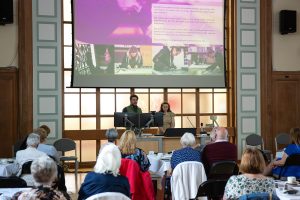By Sarah Griffiths and Claire Chatterton
On 7 June 2023, the University of Chester’s Faculty of Health, Medicine and Society (FHMS) Historical Society hosted an event at the University’s Wheeler Building, when four stained glass windows from the former Chester Royal Infirmary were unveiled in their new home. The windows, three from the Children’s Ward and one from the Chapel, had been in storage since the closure of the Chester Royal Infirmary in 1994 and the conversion of the original 1761 building into apartments.

John Walker, a 1761 Building resident who instigated its blue plaque, felt that the windows, formerly stored in the basement, should be conserved and placed on public display. Being aware of the University of Chester’s Riverside Museum at the Wheeler Building, he approached the University and the 1761 Building RTM Co. Ltd has now loaned the windows for as long as they are on display, in exchange for the funding of their conservation.
The loan of the Chapel window was also supported by Anne, Lady Baker Wilbraham, as it commemorates two family members, Frances and Emily Wilbraham. Frances was described as the ‘Florence Nightingale of Chester’ for her nursing work in the nineteenth century.
The audience gathered to hear John Walker speak about the innovative achievements of Dr John Haygarth at the Infirmary in the eighteenth century, including the establishment of the first hospital fever wards and measures to prevent the spread of smallpox, later adopted nationwide.

[Figure 2] John Walker (Niall Thomas, University of Chester)
Dr Claire Chatterton, Associate Head of School of Health, Wellbeing, and Social Care at the Open University and Visiting Professor at the Universities of Chester and Chichester, described the history and the individuals behind the stained-glass windows. The crucifixion window from the Chapel was one of five designed by Herbert Bryans and installed in 1906 in memory of the Wilbraham sisters. These were financed by public subscription for the women’s contributions to Chester, which included district visiting and nursing cholera patients.
One of the volunteers at the Riverside Museum and former nurse, Sylvia Dunn, recalled the windows in their original home as she used to put out the communion silver and offertory box for the weekly 6am Tuesday service: ‘Those chapel windows became very dear to me as they were installed in the original building … Working at the Royal was the happiest time of my nursing career.’
The Children’s Ward windows, which depict children at ‘Morning’, ‘Noon’ and ‘Night’, were installed in 1920 as part of a refurbishment of the Haygarth Ward for children, since children had been accommodated on adult wards during the First World War. This project was initiated, financed and managed by honorary physician of twenty-one years, Dr George Taylor and Walter Heathcote Williams, a member of the Infirmary House Committee.
Former nurse and Riverside Museum volunteer, Lyn Atherton, remembered the windows in the 1950s when she was on placement:
The windows looked over the children in the ward, much as a modern-day television would, and the sun shone through them. There were very few toys or books and visitors were only allowed for half an hour a day. Children had to be in bed at all times unless they could sit at the table to eat. As a result, they were bored. Nurses used to make up stories about the children in the windows and say how well they behaved to encourage them to follow suit.
Insights into the conservation and repair processes involved were provided by Lee Bilson (Heritage Consultant) and Carlotta Cammelli (Stained Glass Conservator) from Recclesia Stained Glass. This work was carried out as a community project and included partial re-leading, strengthening the lead net, repairing cracked glass, in-filling, plating and cleaning.

[Figure 3] Lee Bilson and Carlotta Cammelli (Niall Thomas, University of Chester)
Professor Dame Jenny Harries, OBE (Chief Executive of the UK Health Security Agency and a Visiting Professor at the University of Chester) and Children’s Nursing student, Nicola Clarke, then unveiled the windows in the presence of the Lord Mayor of Chester, Cllr Sheila Little, to mark twenty nine years since the closure of Chester Royal Infirmary, the seventy fifth anniversary of the NHS, and fifteen years since the founding of the FHMS Historical Society. Guests could then appreciate how these important historical artefacts have been preserved and displayed for the benefit of students, staff and the wider community.

[Figure 4] Nicola Clarke with Professor Dame Jenny Harries, OBE (Niall Thomas, University of Chester)
This event preceded the University’s Annual Haygarth Public Health Lecture for Cheshire, given by Professor Dame Jenny Harries, OBE on ‘Being Prepared for Health Hazards’.

[Figure 5] John Walker, Professor Eunice Simmons, Nicola Clarke, Professor Dame Jenny Harries, OBE, Lord Mayor of Chester, Cllr Sheila Little, Professor Angela Simpson, Dr Sarah Griffiths (Niall Thomas, University of Chester)
